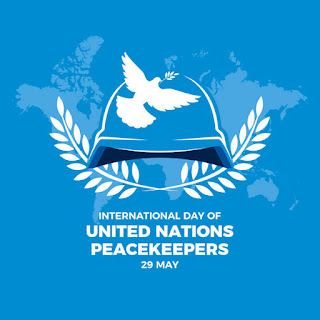📅 May 29
The International Day of United Nations Peacekeepers is observed every May 29 to honor the service and sacrifice of UN peacekeepers—men and women deployed to the world’s most volatile regions to promote peace, protect civilians, and support stability.
Since its first mission in 1948, UN peacekeeping has helped countries transition from conflict to peace through courage, diplomacy, and humanitarian service.
🏳️ Why This Day Matters
-
🛡️ Honors Fallen Peacekeepers: Over 4,200 peacekeepers have lost their lives since 1948.
-
🤝 Recognizes Service: Highlights the contributions of over 90,000 active personnel from 125+ countries.
-
📢 Raises Awareness: Educates the public about UN missions and global cooperation for peace.
📜 A Brief History
-
📆 1948: The first peacekeeping mission—UNTSO—was established in the Middle East.
-
🏛️ 2002: The UN General Assembly officially designated May 29 as Peacekeepers Day.
-
🌍 Missions have taken place in Africa, Asia, the Middle East, Europe, and Latin America.
📊 Quick Facts
-
🌍 12+ active missions in areas like Mali, South Sudan, Lebanon, and the Democratic Republic of Congo.
-
👮 Multinational Forces: Peacekeepers include soldiers, police, and civilians.
-
💙 The iconic blue helmet symbolizes neutrality, courage, and hope.
🌟 Themes (Recent Examples)
Each year has a unique theme.
-
🧭 2024: “Fit for the Future, Building Better Together”
-
⚖️ 2023: “Peace Begins with Me”
-
🛡️ 2022: “People. Peace. Progress. The Power of Partnerships”
🙌 How to Commemorate the Day
🎖️ 1. Attend a Local or Virtual Tribute
-
UN offices and embassies often hold wreath-laying ceremonies.
📘 2. Learn About UN Peacekeeping
-
Explore documentaries, news features, or UN resources on peace operations.
🕯️ 3. Light a Candle for the Fallen
-
Honor those who gave their lives in pursuit of peace.
📢 4. Share on Social Media
-
Use hashtags like #UNPeacekeepers and #ServingForPeace.
🧩 5. Join a Peacebuilding Activity
-
Participate in interfaith talks, school discussions, or peace art workshops.
🕊️ UN Peacekeepers' Roles
-
👩⚖️ Protecting Civilians
-
🧱 Disarming Combatants
-
📚 Supporting Elections and Rule of Law
-
🚑 Providing Medical and Humanitarian Aid
-
🕵️ Monitoring Ceasefires and Demobilization
🌈 Conclusion
The International Day of United Nations Peacekeepers is a reminder that peace is never passive. It takes courage, cooperation, and compassion. On May 29, we salute those who put themselves on the line to protect peace—and recommit to doing our part.
💬 "Peacekeeping is not a job for soldiers, but only soldiers can do it." – Dag Hammarskjöld, former UN Secretary-General

Comments
Post a Comment